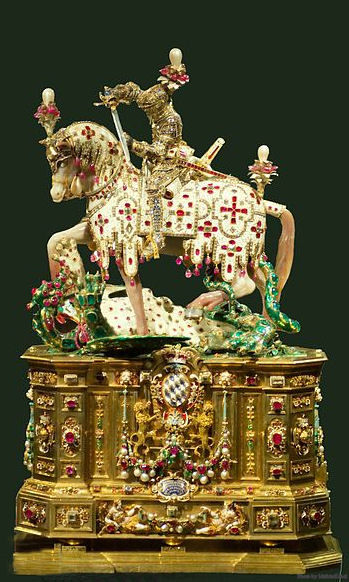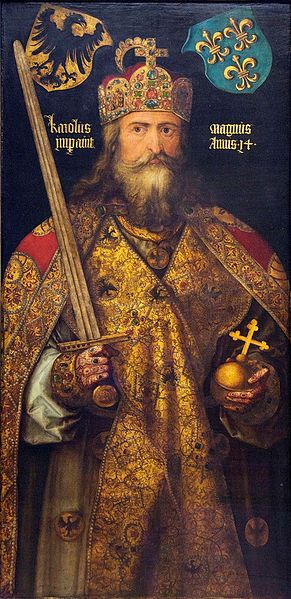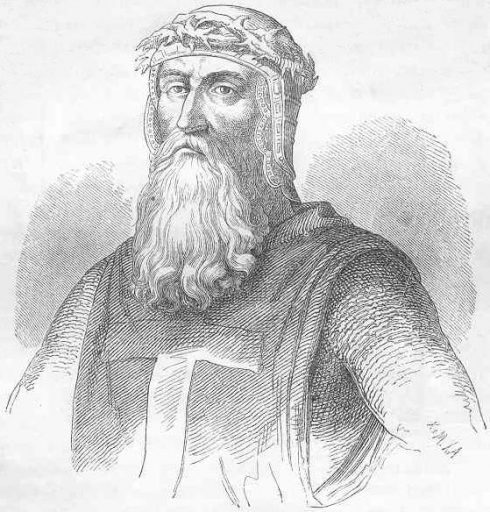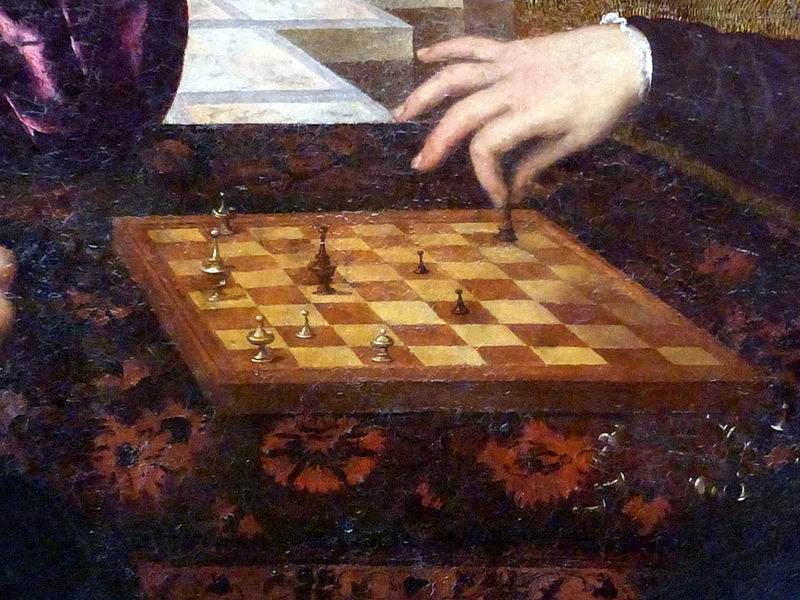“Your mother, my child, has correctly quoted the familiar sayings which are in vogue amongst young people. But it is with the prouder words which have sprung forth from the hearts of our poets, and which will one day attain to the dignity of proverbs, that I would have you to do. These are more worthy of you and constitute the code of honor.
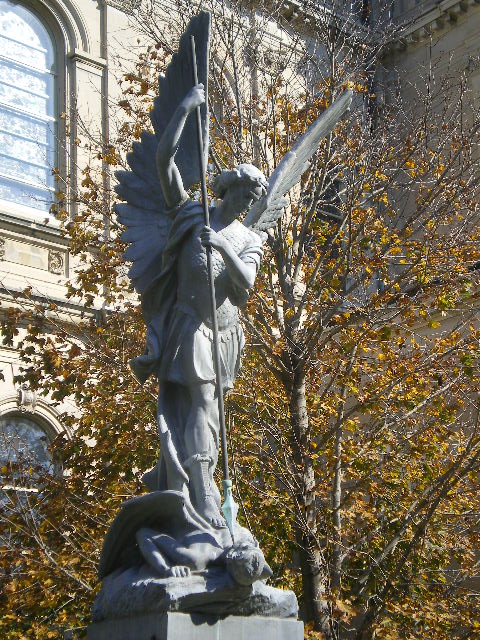
Statue of St. Michael at the Shrine of St. Theodore Guerin, the 8th American Saint, located in Terre Haute, Indiana.
“‘Death rather than dishonor,’ was the cry which Roland uttered in the valley of Roncesvalles before the great battle with the infidel; it is the cry of every Christian baron, and will be yours too, my son, on every solemn occasion of your life. They told you the other day that ‘the heart of a man is worth all the gold in the country,’ and that ‘fins cuers ne peut mentir.’ Weigh all these in your memory, and so act upon them that people may say of you as they said of Ogier—
‘Molt fu preudom; si ot le cuer entire.’
It is the most beautiful funeral oration that any true knight could desire.”
“Since they have held up Ogier to you as a model, remember, my son, that the knight has models in Heaven, and so lift your eyes on high. The Prince of the Celestial Chivalry is Saint Michael: he is the conqueror in the great and invisible battle in which were vanquished those vassals of God who one day revolted against the Sovereign Lord. I hope, my son, that you and I will soon go together, and perform the pilgrimage of ‘Saint Michel de Peril de la Mer,’ for the archangel is the great patron, not only of chivalry, but of the whole of France.

Le Mont-Saint-Michel, in in Normandy, France. Popularly nicknamed “St. Michael in peril of the sea” by medieval pilgrims making their way across the flats.
“In imitation of such a champion the very angels and saints have not disdained to be made knights, and to fight in mortal forms amid the ranks of the Christian army. At the commencement of the celebrated battle of Aspremont, in which Roland revealed himself and gained the sword Durendal, three mysterious knights were suddenly perceived descending in light from the mountain, seated upon great white horses: these knights were Saint George, Saint Domininus and Saint Maurice, who had quitted the ‘flowers of Paradise’ with the express object of couching a lance and striking a blow for our knights below.
“But why go back so far? You are aware, my son, of the incomparable expedition which ended in the capture of the Holy City of Jerusalem. There were saints and angels everywhere. It was as if a flight of falcons were hovering over our army, and had then cast themselves in terrible attack upon the infidels. On one day, there were thirty thousand amongst us plus blaus que flors de pres. There, there, my son, are your models, and I often permit myself to hope that you will become another Saint George—another Saint Maurice. Let me retain this hope.”
“Your mother has high aspirations, and she is welcome to them. I am more moderate, and propose to you only human models. Still, do not let me go too far in the impetuosity of my wishes. Certainly, it would not be displeasing to me to see you resemble Roland, who knew how to meet death in a manner which no mere mortal man ever did (save One); to that Roland who expired on the mountain, where he could overlook Spain and the infidels, holding his own against one hundred thousand men, preserving his sword, having time to repeat his mea culpa, and gaining the victory just before his death. I prefer to him, perhaps, Oliver, who is less sublime and more practical; but that is an opinion which I would not wish to defend too far.
“I also delight in the rough Guillaume—‘au fiers bras’—whose sword many times freed the Christian race, and who died a monk at Gellone; or the youthful Vivien, who fell in the field of battle at Aliscans when the angels came down to carry his soul to Heaven. Or again, Renaud de Montauban, who to expiate his sins consented to conceal his glorious name and to become a bricklayer’s laborer at Cologne.
“For some time we have heard of the Nine. Nine heroic examples or models, which should represent to our eyes all that has ever been the most valiant and generous in the enterprises of the greatest captains. Joshua was for a long time the arm and sword of Moses; David distinguished himself both as a soldier and as a knight, as well as a penitent and a prophet. It was Judas Maccabeus who delivered his countrymen.
“These form the first group of the nine heroes, the first and not the least grand.
“Hector, Alexander and Caesar compose the second, which sums up Troy, Greece and Rome. But I would prefer to direct your attention to the third group, in which shines out the glory of Arthur of Britain, Charlemagne of France, and Godfrey of Bouillon.
“I do not wish to hide from you the opinion that I prefer Godfrey of Bouillon to any of the other eight heroes, and that he is the hero upon whom I wish to model myself and you after me. I consider that he resembles Roland as much as Oliver, with, I cannot tell you how much, more piety and sanctity. He was as gentle as he was brave, and this man, of whom all the Crusaders could say as they saw him pass by—“There is duke Godfrey, who has the heart of a lion’—that warrior was as gentle as a lamb.
“I am of the opinion that no one like him knew the great mystery of the Crusade, and he ceased not for one moment throughout that war of unparalleled duration to distinguish himself by a singular moderation, which, however, never permitted anyone to question his courage. His companions could perceive that he was always thinking of Christ even in the very thick of the battle, and the idea of the Cross was ever present in his calm and tranquil mind. Two sayings of his, two sayings only, paint the character of the man. He pronounced the first at the Gate of David during the final assault on Jerusalem. He said, ‘Do not fear death—seek it!’ It was to his brothers—remark, to his brothers—that he addressed this grand exhortation. You know the other utterance, which will be repeated to the end of time by all true knights.
“‘God forbid,’ said the newly-made King of Jerusalem, ‘God forbid that I should wear a crown of gold where He wore a crown of thorns.’
“He remained during the rest of his life grave and pensive, thinking always of his Master.
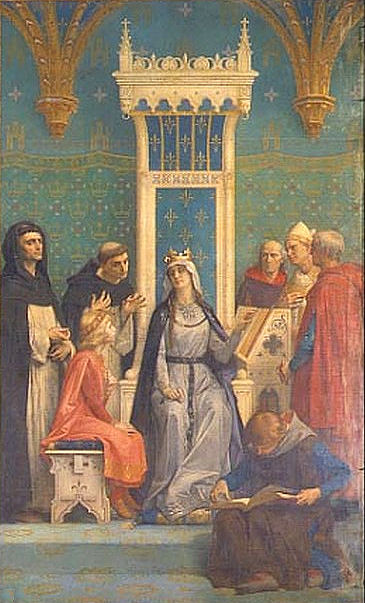
St Louis being taught by his Mother. She impressed this on him in a particular manner with her statement: “I love you, my dear son, with all the tenderness a mother is capable of; but I would infinitely rather see you fall down dead at my feet, than that you should ever commit a mortal sin.” St. Louis went on to tell his eldest son before his death: “Keep thyself from doing aught that is displeasing to God, that is to say, from mortal sin. Contrariwise thou shouldst suffer every manner of torment rather than commit a mortal sin.”
“No one ever saw such a crusader as he. But perhaps I am putting before you too elevated an example, and I think it would be better to propose to you a more accessible model.
“In fact, I would not desire a better model than the cousin of Girart de Roussillon, who was called Fouque, and whose exploits the troubadour sang to us the other day, thus—
“‘Fouque was heroic, courteous, frank, good, and a facile speaker. He was a most skillful hunter in the forest, the wood or the marsh; he knew chess, backgammon and dice. His house was never closed to anyone. He gave as he was asked. Good or bad, everyone had a share in it, and he was never slow to bestow largesse. He was supremely pious, for, although he was of the world, he never was in a court where was proposed or accomplished a single act of injustice, without being profoundly moved if he could not prevent the execution of it. He detested war, and loved peace: when he had his helmet laced, his shield around his neck, his sword by his side, then he was proud, furious, impulsive, superb, merciless, pitiless; and when pressed by a crowd of armed men, then he showed himself the firmest and most brave. They could not make him budge an inch, and there was not one man on earth who would cope with him. He always loved brave knights, and honored the poor as well as the rich. Everyone, powerful or weak, found in him their support.’ Decidedly, my son, he is your model.’”
“Yes!” repeated his mother. “There is your model. Now, my dear child, go and rest, after this long lesson. If you only retain a sentence of it, let it be this, in which all your father’s teaching and mine is summed up:—
‘Do your duty come what may.’
“The rest matters little. Kiss me, my child.”
León Gautier, Chivalry, trans. Henry Frith (London: George Routledge and Sons, Ltd., 1891), 113–17.
Short Stories on Honor, Chivalry, and the World of Nobility—no. 697

